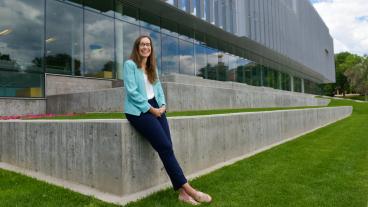As the population in U.S. urban communities continues to grow exponentially, so does the demand for appropriate housing and office space. Typically, in large urban areas this means building residential and commercial units that are up to 20 stories high, made with concrete or steel, as it has been done in the past century. Yet sometimes, these materials are not ideal in earthquake-prone areas.
 |
A new timber structural innovation, known as cross laminated timber (CLT), is being implemented around the world as a sustainable alternative to conventional structural materials. In comparison to building with steel and concrete, timber outperforms in lightness, cost, speed of construction, and environmental impact. However, building tall with cross laminated timber has been limited in earthquake active regions, since a validated design method for tall CLT buildings to resist earthquakes has not yet been developed. Colorado School of Mines plans to change that, with the development of a resilience-based seismic design for tall timber construction.
Civil and Environmental Engineering Assistant Professor Shiling Pei aims to develop a seismic design methodology over the next four years for resilient tall wood buildings. “This project, scientifically, will answer a lot of questions we have regarding how to design [these buildings] and how to perfect their performance in earthquakes so that the buildings can be immediately reoccupied after a big earthquake,” said Pei, who is also the principal investigator on a $1.5 million award from the National Science Foundation (NSF) for the project, A Resilience-based Seismic Design Methodology for Tall Wood Buildings.
With six universities and multiple domestic and international industry partners collaborating on this project, researchers will design, build and validate the performance of a 10-story wood building by conducting a full-scale sub-assembly system testing at the Natural Hazards Engineering Research Infrastructure (NHERI) experimental facility at Lehigh University in Bethlehem, Penn. This will then be followed by a full-scale test at the NHERI outdoor shake table at the University of California at San Diego—the largest outdoor table in the world.
The model tested on the shake table will be an actual building designed to a resilience performance target, Pei explained, with everything from the finishing drywall to the windows. “This will be the largest building that has been tested on the shake table,” said Pei. But since this is a full-scale model and includes all building components, not just the structural framework, the project can get expensive.
In addition to the support from NSF, the research team still needs to raise approximately $800,000 in order to complete the project. They have already received interest from most industry leaders who see the benefits of their work, which would enable a new sustainable construction practice that is also cost-competitive. If successful, implementing the design method would increase the demand for engineered wood production, providing added value for forest resources and enhancing job growth in construction and forestry sectors.
The researchers expect to have all the designs and donations lined up by the end of 2019 with building anticipated to begin in 2020. “We are excited about the new data this landmark experiment will generate,” said Pei. “It could have an enormous impact on the tall timber building industry, and lead to new building practices using more sustainable materials.”
Contact:
Ashley Spurgeon, Editorial Assistant, Mines Magazine | 303-273-3959 | aspurgeon@mines.edu
Deirdre Keating, Communications Manager, College of Engineering & Computational Sciences | 303-384-2358 | dkeating@mines.edu



